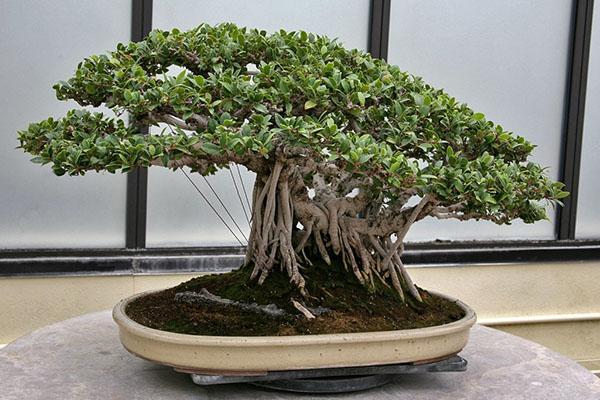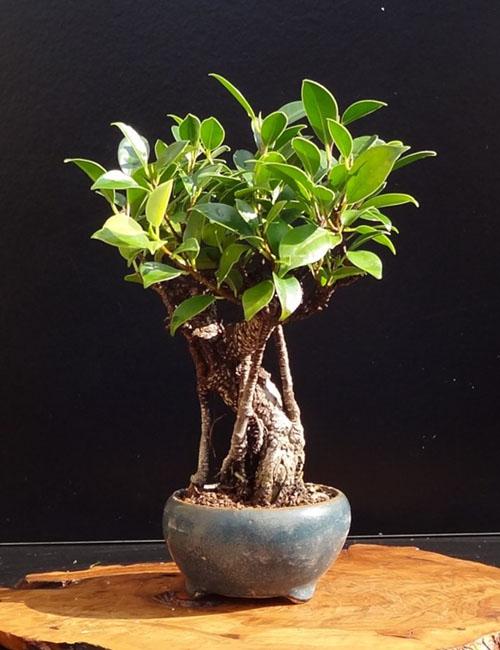Ficus microcarpa: general characteristics, reproduction, home care
 Ficus microcarpa is a representative of the unique Mulberry family. Translated from Latin, the name of the plant means "ginseng". And this is not in vain. The original trunk-root of the ficus resembles the tubers of this plant. Although it is obtained thanks to special agricultural technology. Ficus microcarpa is often used as bonsai novice florists. Its maximum height indoors reaches 1.5 m. In natural conditions, the tree grows up to 25 m in height. What else is remarkable about this unique flower? Let's look at it from the side.
Ficus microcarpa is a representative of the unique Mulberry family. Translated from Latin, the name of the plant means "ginseng". And this is not in vain. The original trunk-root of the ficus resembles the tubers of this plant. Although it is obtained thanks to special agricultural technology. Ficus microcarpa is often used as bonsai novice florists. Its maximum height indoors reaches 1.5 m. In natural conditions, the tree grows up to 25 m in height. What else is remarkable about this unique flower? Let's look at it from the side.
General description of the plant
 Experts have more than 600 varieties of such plants. The elite ficus microcarpa is considered a fast growing crop that easily adapts to new conditions. The main feature of the tree is a unique root system and a powerful stem. Small dark green oval leaves grow on it. In general, they resemble foliage. ficus benjamin.
Experts have more than 600 varieties of such plants. The elite ficus microcarpa is considered a fast growing crop that easily adapts to new conditions. The main feature of the tree is a unique root system and a powerful stem. Small dark green oval leaves grow on it. In general, they resemble foliage. ficus benjamin.
In addition, the plant has several heavy aerial roots that resemble the trunks of ancient trees. And the pot-bellied torso looks like a ginseng root. Outside, it is dotted with many stripes, like a live tiger. The color of the bark can be gray, brown and even slightly reddish.
 In its natural environment, ficus microcarp is found in Southeast Asia as an evergreen tree. An adult tree has a powerful trunk from which aerial roots gracefully hang. It is crowned with a lush crown, consisting of many curved shoots covered with glossy foliage.
In its natural environment, ficus microcarp is found in Southeast Asia as an evergreen tree. An adult tree has a powerful trunk from which aerial roots gracefully hang. It is crowned with a lush crown, consisting of many curved shoots covered with glossy foliage.
In nature, ficus ginseng, as it is also called, is a strangler plant. First, it grows to the surface of the bark of someone else's tree, puts down aerial roots, entangles the "victim" and, as a result, slows down its growth.
Ficus microcarpa: breeding methods at home
 Gardeners practice several options for breeding an exotic plant. The most popular of them are cuttings and seeds. Each of them has its own characteristics, but it takes a lot of effort, patience and time.
Gardeners practice several options for breeding an exotic plant. The most popular of them are cuttings and seeds. Each of them has its own characteristics, but it takes a lot of effort, patience and time.
Most often, indoor plant lovers propagate ficus microcarp by cuttings, performing the following actions:
- cut off the shoot at an oblique angle (distance from the nodes 1 cm);
- fill containers made of dark glass or plastic with warm water;
- put scraps in them;
- after 24 hours, the water is drained;
- prepare a new liquid by adding a little ash there;
- when the roots appear, they are planted in containers;
- cover the seedlings with plastic wrap to create a greenhouse effect;
- after the formation of leaves, the shelter is removed.
 Some gardeners plant the cuttings directly into the ground, submerging the cuttings about 5 cm. In order for the shoots to take root, they are regularly moistened with a sprayer. After 30 days, the seedlings will get stronger and new leaf plates will appear.
Some gardeners plant the cuttings directly into the ground, submerging the cuttings about 5 cm. In order for the shoots to take root, they are regularly moistened with a sprayer. After 30 days, the seedlings will get stronger and new leaf plates will appear.
You can also dilute ficus with purchased seeds. For this, a number of simple processes are performed:
- planting material is soaked in a growth stimulator;
- prepare containers with light soil that contains sand;
- seeds are sown at a distance of 2 cm from each other;
- moisten the topsoil using a spray bottle;
- containers are covered with glass or foil.
In order for the sprouts to "breathe" fresh air, the coating is removed for a few minutes every day. When the first leaves are formed, they are transplanted into separate pots.
It is advisable to moisten the soil as the top layer dries.
Reasonable approach to plant care
 As you know, ficus microcarp is an unpretentious culture. However, some rules must still be followed. When choosing a place in the room, it is important to consider that he does not like direct sunlight. Therefore, the flower is placed in the shaded parts of the house. In addition, the temperature must not drop below 17 ° C.
As you know, ficus microcarp is an unpretentious culture. However, some rules must still be followed. When choosing a place in the room, it is important to consider that he does not like direct sunlight. Therefore, the flower is placed in the shaded parts of the house. In addition, the temperature must not drop below 17 ° C.
In some cases, the ficus microcarpa sheds its leaves. What to do and how to save the plant? Often these factors are behind this:
- change of habitat;
- drafts;
- temperature changes;
- excess moisture;
- dry air;
- pests.
 When the reason is found out and eliminated, the flower again pleases the eye with its beauty. It is equally important to know how to shape the microcarp ficus in order to maintain its amazing shape. Usually in flower shops special preparations are used that slow down the pulling of branches up. Over time, the influence of retenders ceases. As a result, shoots begin to grow, irregular leaves appear and roots shrink. Therefore, it is necessary to regularly trim the microcarp ficus to keep it in proper form.
When the reason is found out and eliminated, the flower again pleases the eye with its beauty. It is equally important to know how to shape the microcarp ficus in order to maintain its amazing shape. Usually in flower shops special preparations are used that slow down the pulling of branches up. Over time, the influence of retenders ceases. As a result, shoots begin to grow, irregular leaves appear and roots shrink. Therefore, it is necessary to regularly trim the microcarp ficus to keep it in proper form.
The pruning procedure is best done in summer, when there is a lot of light and a comfortable temperature and humidity.
Important watering conditions
 The plant needs moisture when the topsoil dries out to a depth of 3 cm. The distance is measured with a regular ruler. In addition, the tree loves to be often sprayed. At the same time, they try to prevent water from getting on the trunk and air roots of the ficus. Water the culture about 1 time per week.
The plant needs moisture when the topsoil dries out to a depth of 3 cm. The distance is measured with a regular ruler. In addition, the tree loves to be often sprayed. At the same time, they try to prevent water from getting on the trunk and air roots of the ficus. Water the culture about 1 time per week.
Planned ficus transplant
 Sooner or later, the plant needs updating. Therefore, it is transferred to a new container.
Sooner or later, the plant needs updating. Therefore, it is transferred to a new container.
To transplant ficus microcarp, perform a number of actions:
- moisturize the soil of the plant;
- carefully remove it from the pot;
- cut the rhizome by about 1/3 to create a compact tree shape;
- place the ficus in a new pot.
After the procedure, the plant is slightly moistened and placed in a shaded place. After transplanting, the tree sheds its leaves, which indicates the adaptation process. Over time, it will end and foliage will reappear on the branches.
The container for planting the ficus should have a hole at the bottom into which excess liquid will go.
Having considered in detail the secrets of caring for the ficus microcarp at home, it is worth noting that there is nothing complicated in this. The main thing is to adhere to the advice given by experts in order to do everything right.